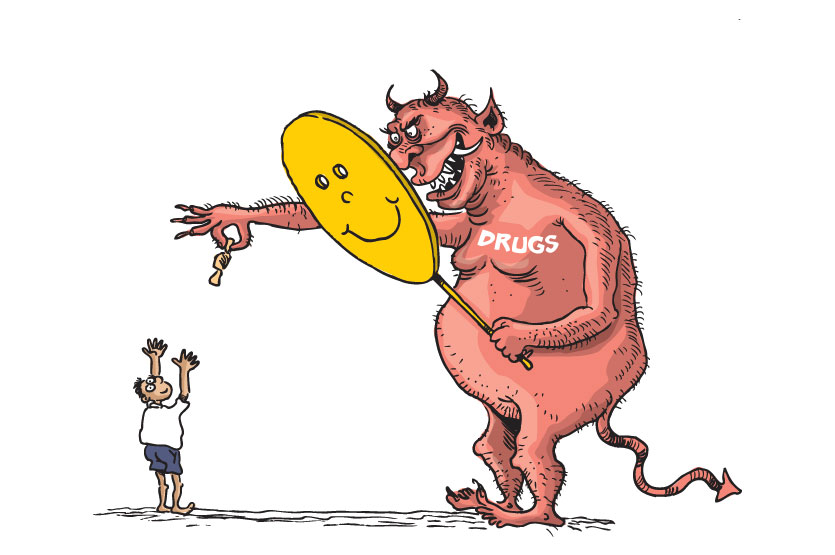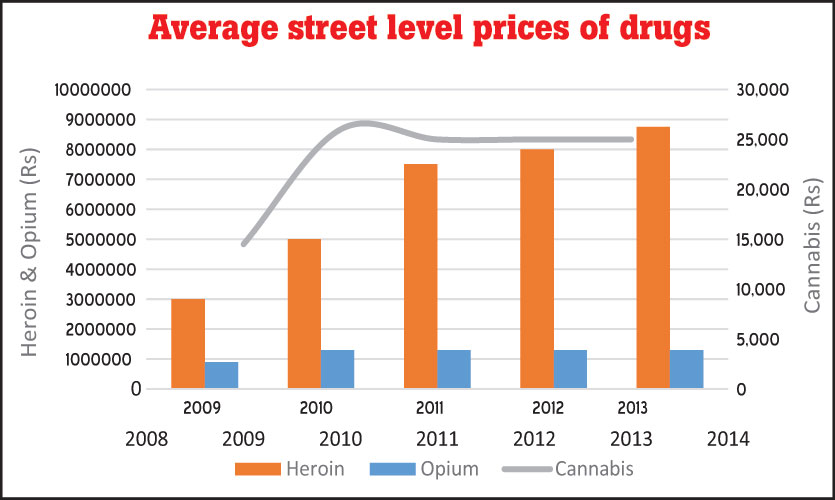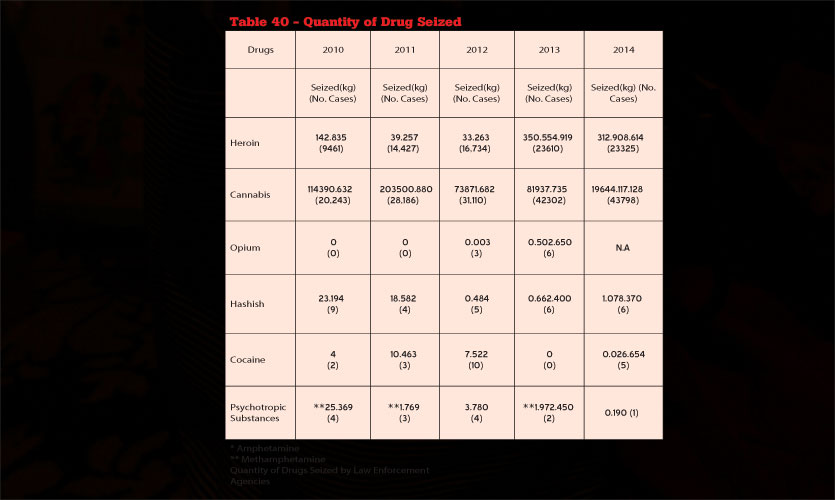Feb 03 2017.
views 1613They come in many forms - from powder to stamps and even as candy – so what’s been done to dissuade our youth from giving into peer pressure? And how do we tell them that there is nothing ‘cool’ about trying it for pleasure?

Habits of substance abuse have prevailed in Sri Lanka due to various socio-economic factors. But today, we could see that this trend has approached all age groups irrespective of religion, caste or gender. When weighing the consequences of these practices, it is quite evident that various ‘dealers’ around the country are looking at ways to market their products. Although there are various institutions and programmes to monitor and eventually reduce and prevent substance abuse, there doesn’t seem to be any change in the trend. In an attempt to shed light on the concerns of this matter, Life Online spoke to a few individuals of varied expertise to listen to their opinions regarding this issue.
A behavioural and a policy change is the need of the hour: ADIC
Speaking to Life Online, Programme Officer at the Alcohol and Drug Information Centre, Asitha Dharshana Fonseka said that the media has a huge role to play when reporting issues related to substance abuse. “There is a growing trend to introduce substances other than alcohol and tobacco especially for school children. Children have been introduced to substances like ‘baabul’ and ‘pampara’ from their younger days. This is a stepping stone for them to be introduced to alcohol, tobacco and other drugs. Drugs come in the form of LSD, stamps, gummy bears and they have been glamorised in such a way that the youth would find it as an ‘interesting’ thing to spend their time on. Quite recently some students in a reputed school in Colombo showed me a straw the size of a finger with an extremely sweet substance. Some would just take it as a sweet substance but when you closely examine you would also feel that it is a substance made out of crushed cigarettes. On another instance a certain kind of spray became quite popular in schools. Here the users could spray the substance in their mouth which is even more effective. Through the use of these drugs, children feel they are taking a break from their daily routines and do something different. This makes it more interesting for them.”
Speaking further he said that different kinds of drugs are used in different settings. “The behaviours of drug users too are learned. I have come across children who have found alternative methods of consuming drugs once they are deprived of it. It all depends on the mentality. The image that has been designed around any drug is quite tempting and this is what the youth wants. Alcohol and other drugs are depressants but the opposite is being practiced. The concept of drugs revolves around recreation and entertainment. On the other hand the prevention programmes in the country too are not attractive. The Presidential task force would conduct programmes with speeches and other activities which the youth wouldn’t be interested in. Therefore I believe that there needs to be a behavioural as well as a policy change in trying to address this issue.”
Prevention is of utmost importance: Dr. Samantha Kithalawaarachchi
Expressing his views on this topic, Dr. Samantha Kithalawaarachchi, Director of the Presidential Task Force on Drug Prevention said that many drug dealers have identified the Colombo Port as a safe port and transit point. “We have come across drugs such as hashish, cocaine, cannabis and many other substances. The Presidential Task force comprise many institutions such as the Police Narcotics Bureau, Sri Lanka Navy, Sri Lanka Customs and many others to ensure that we carry out an effective programme island wide. During the recent raids we saw that school children too have been victimised in this business. Therefore parents should be quite vigilant about their children as they would fall prey. In addition to that teenagers believe that taking drugs at a party or other social function is something that they should do in order to maintain friendships with others. This is mostly evident in teenagers in the elite society. Also there are certain myths revolving around these drugs. Children have been brainwashed with a message saying that when they take heroine they will be able to stay up late at night and study. Yet the opposite could be seen as they would suffer from memory loss and brain damage as a long term effect. While conducting a programme in Polonnaruwa we also came to know that many bus drivers too are under the influence of drugs. This would keep them awake during their ride but in the long term it could be quite dangerous.
He also said that drugs are transported in to the country mainly through fishing boats. They also reach the users via online transactions. “Certain tourists also bring them in to the country and distribute among beach boys and others in the industry. As of now there are between 45,000-50,000 drug users in Sri Lanka. We are doing our best to arrest them and put them in to rehabilitation centres. Prevention is what is most important because once a person gets addicted to these drugs it takes a long time for them to return to their normal selves.”
Children are unaware of the side effects of drug abuse: NDDCB
In her comments Bhadrani Senanayake, Assistant Research Officer at the National Dangerous Drug Control Board (NDDCB) said that in most instances children are unaware of the side effects of drug abuse. “Parents have a huge role to play in keeping their children away from drugs. Children are sometimes forced in to these activities. They will be exposed to drugs through their friends and with the curiosity they would want to test them. This would eventually encourage them to take more and more. Children above 12 years are mostly vulnerable for substance abuse.
Drugs cause dramatic changes to the brain: Dr. Ramani Ratnaweera

Dr. Ramani Ratnaweera, consultant psychiatrist at Karapitiya Teaching Hospital said that substance abuse eventually increases the dopamine levels in the brain. “There are drugs such as cocaine, heroin and other tablets which are quite addictive. These drugs cause dramatic changes to the brain eventually delivering intense pressure. Therefore drug abusers would seek for this substance than other rewards such as food, clothes and the like. Quite a number of short term effects could be identified through substance abuse including extreme happiness, hyper reality, hypersensitivity to light, sound and touch, irritability, violence and bizarre behaviour. Long term effects include delusional disorder, schizophrenia, anxiety, depression, nausea and family disharmony. In the case of women it would even lead to miscarriages. Drug abusers are usually depressed because these substances are depressants. There are various programmes held at national level to rehabilitate drug abusers and send them back to the community. It is important that they are given an insight in to healthy living and how to improve their quality of life.”
Things to note:
Symptoms of substance abuse
The symptoms of substance abuse will vary depending upon the substance, the individual’s genetic makeup, the length of abuse, and the frequency of abuse. Some of the common symptoms of drug abuse may include:
· Mood swings
· Anxiety
· Depression
· Irritability
· Euphoria
· Periods of hyperactivity
· Agitation
· Trouble in interpersonal relationships
· Decreased motivation
· Physical dependence upon drugs
· Infections
· Changes in sleep or appetite
· Lethargy
· Paranoia
· Hallucinations
· Changes in personality or attitude
· Violent, angry outbursts
· Fearfulness
· Aggressiveness
Effects of drug abuse
The effects of addiction and abuse of drugs can be all-encompassing, leaving virtually no part of an addict’s life untouched. While the effects of chronic drug abuse will vary among individuals, the most common effects of drug abuse may include:
· Addiction
· Tolerance
· Unintentional injuries
· Accidents
· Damage to all organ systems in the body
· Weakening of immune system
· Increased infections
· Cardiovascular complications
· Nausea, vomiting, and abdominal pain
· Liver damage and/or failure
· Seizures
· Strokes
· Heart attacks
Withdrawal symptoms
The effects of drug withdrawal will vary wildly based on the type of drug abused, the length of abuse, the presence of addiction to one or more drugs, frequency of abuse, and amount used. Some of them include:
· Nausea
· Vomiting
· Insomnia
· Restlessness
· Depression
· Anxiety
· Excessive sweating
· Tremors or shaking
· Seizures
According to a report submitted by the National Dangerous Drug Control Board the following statistics were found during the previous years:


3 Comments
Sonali says:
Feb 05, 2017 at 08:53 pmGive the drugs enforcement officers and police authority to arrest and prosecute those who smuggle drugs, this includes politicians and any henchmen of politicians. If the president can implement it the problems related to drugs will soon be history. The addiction rate has not shown any decline even with the media stepping in to educate the public of the dangers of drug abuse.
ANTON says:
Feb 06, 2017 at 04:50 pmONLY SMALL PACKETS ARE BEING CAUGHT, NOT HUGE CONTAINERS.
Dilan Silva says:
Feb 06, 2017 at 05:36 pmProhibition of any substance never won...the black market will always profit out of it. The answer is not to legalize it but to decriminalize it and treat it as a health issue. Look at what the United nations are calling out for now...i hope the Sri Lankan Government get some enlightenment (specially this president) and implement the correct policies to save our Youth.... BTW CANNABIS (THC) and HASHISH(THC) is the same DAMN DRUG. GANJA=THC... Get your facts right